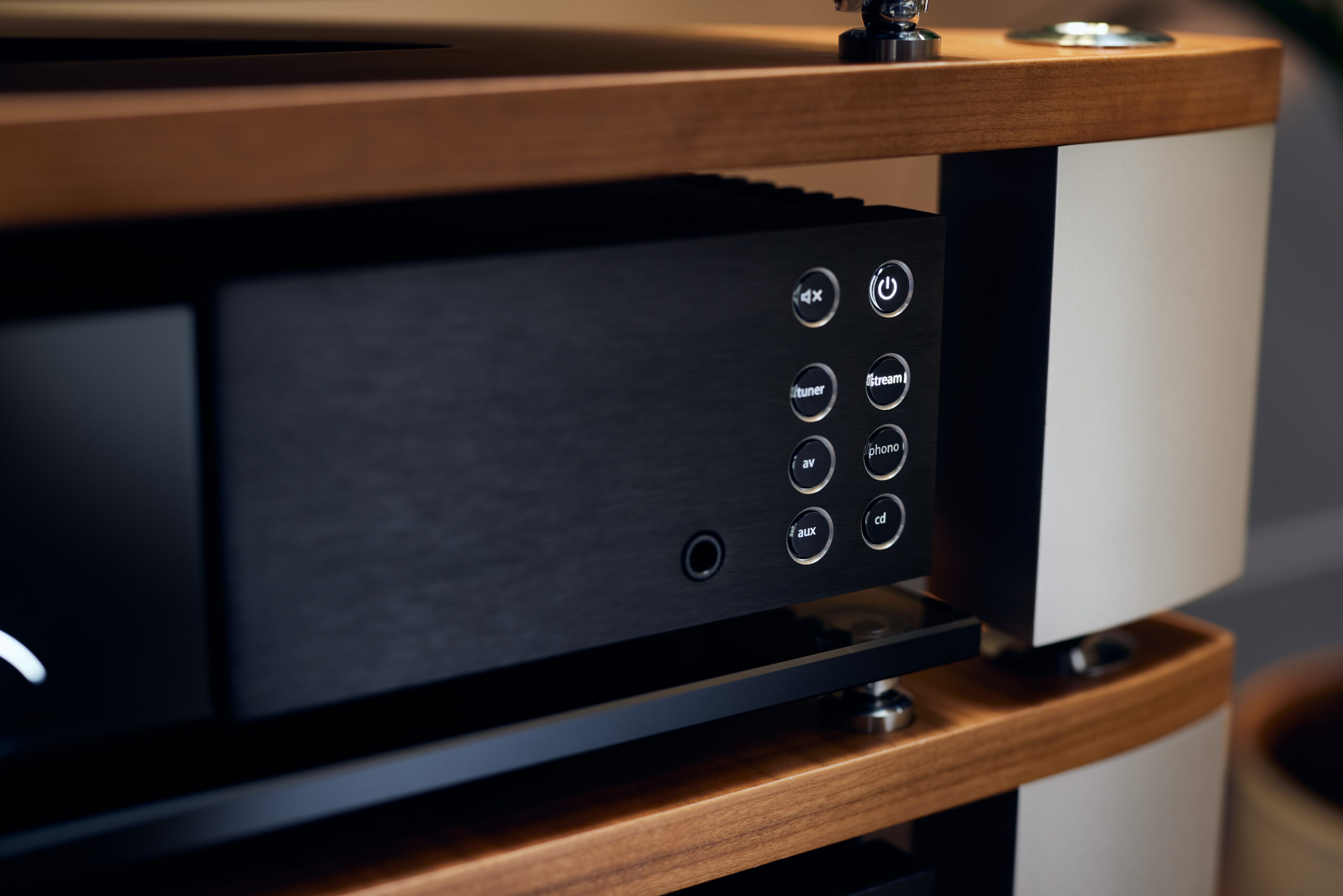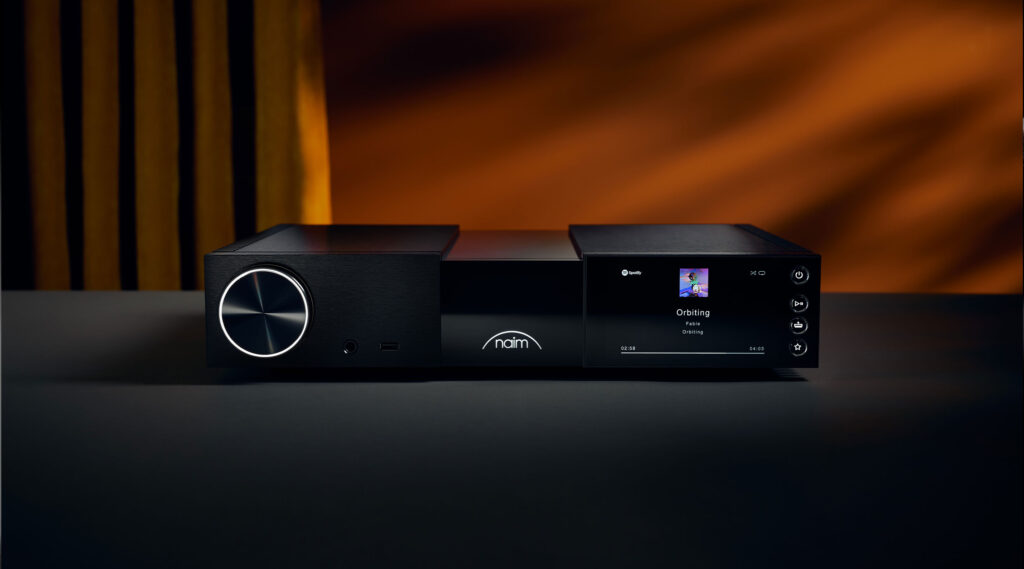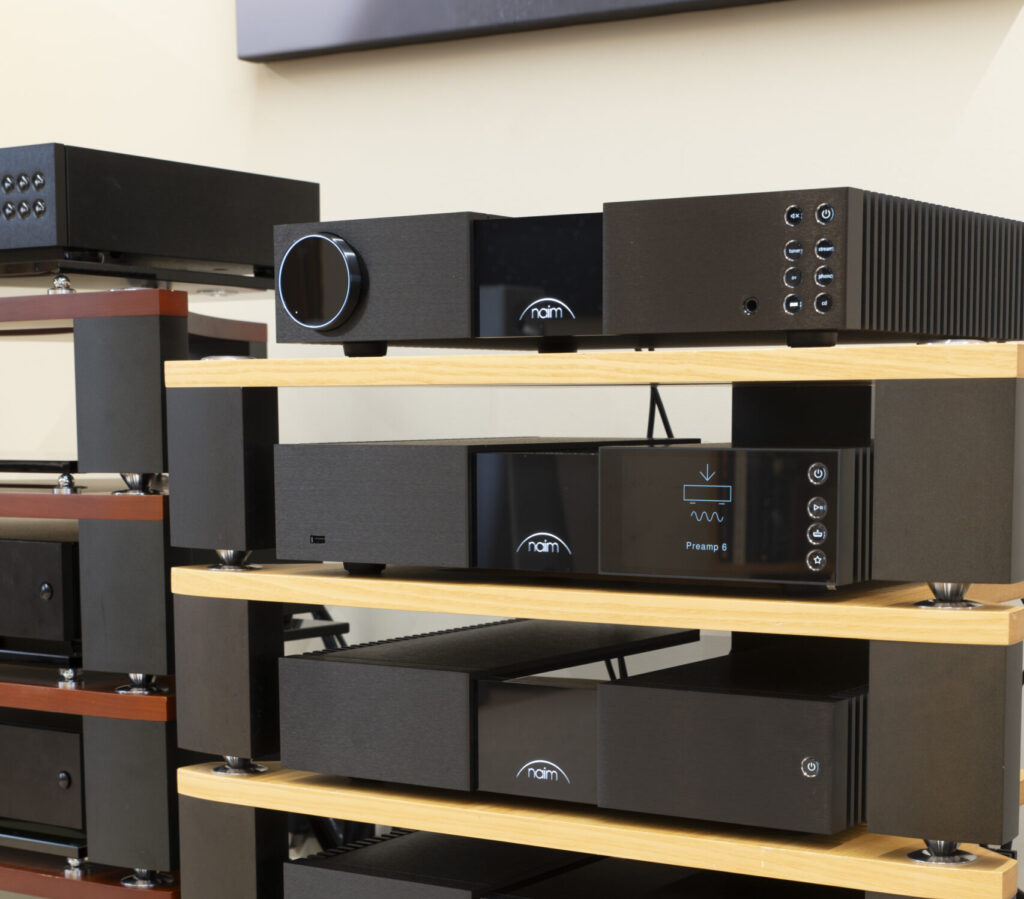Naim 200 and 300 series comparison

Now that we’ve had the New Classic 200 and 300 components from Naim in store for a while, we thought it would be useful to compare all iterations from both series to see what improvements can be had as you move up the range.
One aspect we were keen to explore was the impact the NPX300 has when added to the NSC222, as this takes the combined streaming pre-amplifier to the top of its performance potential: does that pairing outperform the 300 system’s separate streamer and pre-amplifier without the NPX300?
Then we wanted to see where a single NPX300 was most effective with the 300 series components – was it best connected to the NSS333 streamer, or the NAC332 preamp?
We connected all variations with Naim interconnects and speaker cables for consistency and hitched it all up to a pair of YG Acoustics remarkable Ascent loudspeakers in our largest demonstration room.

System #1 NSC222 and NAP250
We began with the two-box Naim 200 system, comprising the NSC222 streaming preamplifier and the latest 6th generation NAP250 power amplifier. We limited the music played to two tracks which we thought would highlight different aspects of performance – namely Prince’s ‘Purple Rain’ and Benjamin Britten’s Young Person’s Guide to the Orchestra with the Royal Philharmonic Orchestra conducted by Vasily Petrenko (Opus 34 and Fugue).
The sound of the system was pretty good by any one’s standards with the Britten pieces having a generous orchestral sound, and Prince’s complex production filling the room with energy and drama.
System #2 NSC222, NPX300 and NAP250
Having acclimatised ourselves to the sound of the system as standard, we added the NPX300 to the NSC222 streamer/preamp and the improvements were immediately obvious; in the Britten pieces, all of the instruments were more clearly defined, and the bass was deeper and more powerful. The whole presentation was clearer and cleaner, appearing to be more ‘high-resolution’ in presentation. In the Finale where the individual instruments come in one after the other and then combine into a boisterous climax, the sense of separation and richness improved significantly.
With Prince’s Purple Rain, the sonic benefits of the power supply were also clearly audible as with the Britten piece, and they were mirrored almost exactly, despite the very different genre. Prince’s vocals became clearer and cleaner with better space and separation around them and with a larger sense of acoustic, and this was also the case with the many instruments in the mix being better differentiated and easier to follow.

System #3 NSS333, NAC332 and NAP250
Next was the 300 system source and pre-amplifier, here with the NAP250 to minimise the number of components changed and without the NPX300.
Having heard the very noticeable improvements brought about by the NPX300 in the 200 system, we were surprised to hear the extra levels of openness, refinement and clarity delivered by the NSS333 and NAC332 combination with both pieces of music, and without any additional power supply. This was clearly an even better sounding option – albeit at an additional cost of £4,400 over the NSC222/NPX300 combination. Details such as multi-tracking and low level mixed-in echo and vocals in the Prince track were all simply better and more apparent, emerging from a palpably darker background.
In the Britten the music seemed to be more fluid, better organised and with a more convincing sense of ambience and scale. For instance, the when the harp came in, the sound of its inner body and string resonances were noticeably clearer and the flutes seemed lighter and daintier – more freely expressed.

System #4 Adding the NPX300 power supply to the NSS333 streamer
By adding the NPX300 to the NSS333 streamer, the music leapt into a new dimension of tonal warmth, clarity and separation. Prince’s vocals now seemed even more focussed and better projected, becoming cleaner and clearer still, especially where multi-tracked. The fuzzed guitars were somehow more realistically ‘fuzzy’. Various components in this dense mix were even easier to differentiate and pick out. The whole track seemed also to be rhythmically tighter with a better sense of pace – all very much Naim hallmarks.
With The Young Person’s Guide, the very tangible additional texture and body of the 300 components (when compared with the 200 system with the extra power supply), was now augmented further still by the addition of the NPX300, as if the whole orchestra was lifted to another level and playing in a larger space.
As the various instruments came in it was as if one could hear their intrinsic harmonic complexity and tonality more clearly, so that they became even more convincingly realistic. For instance, stringed instruments – from double basses through cellos, violas and violins were all sweeter but not cloying and with a reduction in grain we hadn’t actually realised was present in the 200 combination, and these improvements applied just as much to the woodwind, brass, and tympany.

System #5 Adding the NPX300 to the NAC 332 preamp
We only had one NPX300 available at the time of writing, so our next move was to remove it from the NSS333 and connect it to the NAC332 preamp. Oddly, this was a little disappointing, because the sound on each and every instrument in both pieces of music seemed to collapse, removing all of the very significant audible benefits brought about by of adding the NPX300 to the streamer. The sound was now noticeably ‘flatter’, less tonally rich and more cluttered.
On reflection, this follows Naim’s principle of ‘source first’, improving the front end should bring the most benefit to any system. Removing the power supply and its benefits from the source cannot be compensated by adding it to the preamp that follows it, as once information is lost it cannot be added. Indeed, improving the resolution of a worsened signal by adding the NPX300 to the NAC332 could even be worse!
So in summary, for the 300 series components it’s our view that a single NPX300 really should be added to the NSS333 where the improvements are significant, however, we’re yet to see how the system performs with another added to the NAC332, so that’s one for another time, along with a comparison of the NAP250 and NAP350s – we’ve heard both in isolation with their partnering source and pre-amplifier but not as an A/B comparison on the same front end, so watch this space for that.
![]()
Naim 200 and 300 series comparison

Now that we’ve had the New Classic 200 and 300 components from Naim in store for a while, we thought it would be useful to compare all iterations from both series to see what improvements can be had as you move up the range.
One aspect we were keen to explore was the impact the NPX300 has when added to the NSC222, as this takes the combined streaming pre-amplifier to the top of its performance potential: does that pairing outperform the 300 system’s separate streamer and pre-amplifier without the NPX300?
Then we wanted to see where a single NPX300 was most effective with the 300 series components – was it best connected to the NSS333 streamer, or the NAC332 preamp?
We connected all variations with Naim interconnects and speaker cables for consistency and hitched it all up to a pair of YG Acoustics remarkable Ascent loudspeakers in our largest demonstration room.

System #1 NSC222 and NAP250
We began with the two-box Naim 200 system, comprising the NSC222 streaming preamplifier and the latest 6th generation NAP250 power amplifier. We limited the music played to two tracks which we thought would highlight different aspects of performance – namely Prince’s ‘Purple Rain’ and Benjamin Britten’s Young Person’s Guide to the Orchestra with the Royal Philharmonic Orchestra conducted by Vasily Petrenko (Opus 34 and Fugue).

The sound of the system was pretty good by any one’s standards with the Britten pieces having a generous orchestral sound, and Prince’s complex production filling the room with energy and drama.
System #2 NSC222, NPX300 and NAP250
Having acclimatised ourselves to the sound of the system as standard, we added the NPX300 to the NSC222 streamer/preamp and the improvements were immediately obvious; in the Britten pieces, all of the instruments were more clearly defined, and the bass was deeper and more powerful. The whole presentation was clearer and cleaner, appearing to be more ‘high-resolution’ in presentation. In the Finale where the individual instruments come in one after the other and then combine into a boisterous climax, the sense of separation and richness improved significantly.
With Prince’s Purple Rain, the sonic benefits of the power supply were also clearly audible as with the Britten piece, and they were mirrored almost exactly, despite the very different genre. Prince’s vocals became clearer and cleaner with better space and separation around them and with a larger sense of acoustic, and this was also the case with the many instruments in the mix being better differentiated and easier to follow.

System #3 NSS333, NAC332 and NAP250
Next was the 300 system source and pre-amplifier, here with the NAP250 to minimise the number of components changed and without the NPX300.
Having heard the very noticeable improvements brought about by the NPX300 in the 200 system, we were surprised to hear the extra levels of openness, refinement and clarity delivered by the NSS333 and NAC332 combination with both pieces of music, and without any additional power supply. This was clearly an even better sounding option – albeit at an additional cost of £4,400 over the NSC222/NPX300 combination. Details such as multi-tracking and low level mixed-in echo and vocals in the Prince track were all simply better and more apparent, emerging from a palpably darker background.
In the Britten the music seemed to be more fluid, better organised and with a more convincing sense of ambience and scale. For instance, the when the harp came in, the sound of its inner body and string resonances were noticeably clearer and the flutes seemed lighter and daintier – more freely expressed.

System #4 Adding the NPX300 power supply to the NSS333 streamer
By adding the NPX300 to the NSS333 streamer, the music leapt into a new dimension of tonal warmth, clarity and separation. Prince’s vocals now seemed even more focussed and better projected, becoming cleaner and clearer still, especially where multi-tracked. The fuzzed guitars were somehow more realistically ‘fuzzy’. Various components in this dense mix were even easier to differentiate and pick out. The whole track seemed also to be rhythmically tighter with a better sense of pace – all very much Naim hallmarks.
With The Young Person’s Guide, the very tangible additional texture and body of the 300 components (when compared with the 200 system with the extra power supply), was now augmented further still by the addition of the NPX300, as if the whole orchestra was lifted to another level and playing in a larger space.
As the various instruments came in it was as if one could hear their intrinsic harmonic complexity and tonality more clearly, so that they became even more convincingly realistic. For instance, stringed instruments – from double basses through cellos, violas and violins were all sweeter but not cloying and with a reduction in grain we hadn’t actually realised was present in the 200 combination, and these improvements applied just as much to the woodwind, brass, and tympany.

System #5 Adding the NPX300 to the NAC 332 preamp
We only had one NPX300 available at the time of writing, so our next move was to remove it from the NSS333 and connect it to the NAC332 preamp. Oddly, this was a little disappointing, because the sound on each and every instrument in both pieces of music seemed to collapse, removing all of the very significant audible benefits brought about by of adding the NPX300 to the streamer. The sound was now noticeably ‘flatter’, less tonally rich and more cluttered.
On reflection, this follows Naim’s principle of ‘source first’, improving the front end should bring the most benefit to any system. Removing the power supply and its benefits from the source cannot be compensated by adding it to the preamp that follows it, as once information is lost it cannot be added. Indeed, improving the resolution of a worsened signal by adding the NPX300 to the NAC332 could even be worse!
So in summary, for the 300 series components it’s our view that a single NPX300 really should be added to the NSS333 where the improvements are significant, however, we’re yet to see how the system performs with another added to the NAC332, so that’s one for another time, along with a comparison of the NAP250 and NAP350s – we’ve heard both in isolation with their partnering source and pre-amplifier but not as an A/B comparison on the same front end, so watch this space for that.

